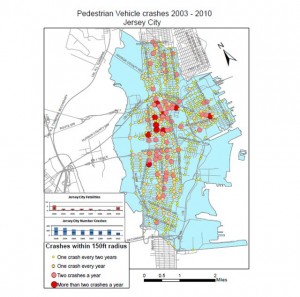Between 2003 and 2010, there were 1,003 pedestrian fatalities and 40,150 pedestrian injuries in New Jersey. Rutgers University’s recent “2011 Pedestrian Safety Tracking Report” provides an in-depth analysis of these pedestrian-vehicle crashes—here are some of their most interesting findings:
-

In addition to its analysis, the Rutgers report contains lots of valuable data visualizations. Older adult pedestrians are over-represented in pedestrian fatalities. The authors write that “pedestrians over the age of 44 become more likely to be involved in a fatal pedestrian crash and that propensity increases with each age category. The older one gets, the more likely it seems pedestrian crashes will be fatal.” TSTC’s yearly analysis of older pedestrians in NY, NJ and CT shows that this trend prevails throughout the region.
- State highways had a greater share of fatalities than county and municipal roads, and injuries on county and municipal roads declined from 2003 to 2010. The report calls out vehicle speed as a key factor in the increased fatalities on state highways. Across the region, transportation advocates and government officials alike have pointed out this connection. There’s even a nascent NYC DOT campaign to address it.
- There is a “spatial pattern of crashes along major transportation corridors.” Maps of crashes in New Jersey’s ten largest municipalities show clusters of crashes “along corridors and at major intersections of multiple corridors” in suburban municipalities. In both Lakewood and Toms River, for example, the US 9 corridor is particularly dangerous for pedestrians. The TSTC found this road to be Ocean County’s most dangerous for bicyclists as well. In urban areas, by contrast, crashes are more evenly distributed, although the crashes are more densely clustered.
While New Jersey may be safer than other places in the US, the report concludes that state’s density and car-dominated development pattern puts pedestrians at risk. “This should be a concern for all transportation planners and policy makers,” states the report. We wholeheartedly agree.

While we reported about your work at TSTC and the report from VTC on WalkBikeJersey, I personally haven’t had much time to review both of these reports. From your conclusions here however, it sounds like high-speed roads that also have multiple lanes are seem to be the most deadly for pedestrians. These conclusions seem to coincide precisely with the opinions of most bike & pedestrian professionals.
Good work!